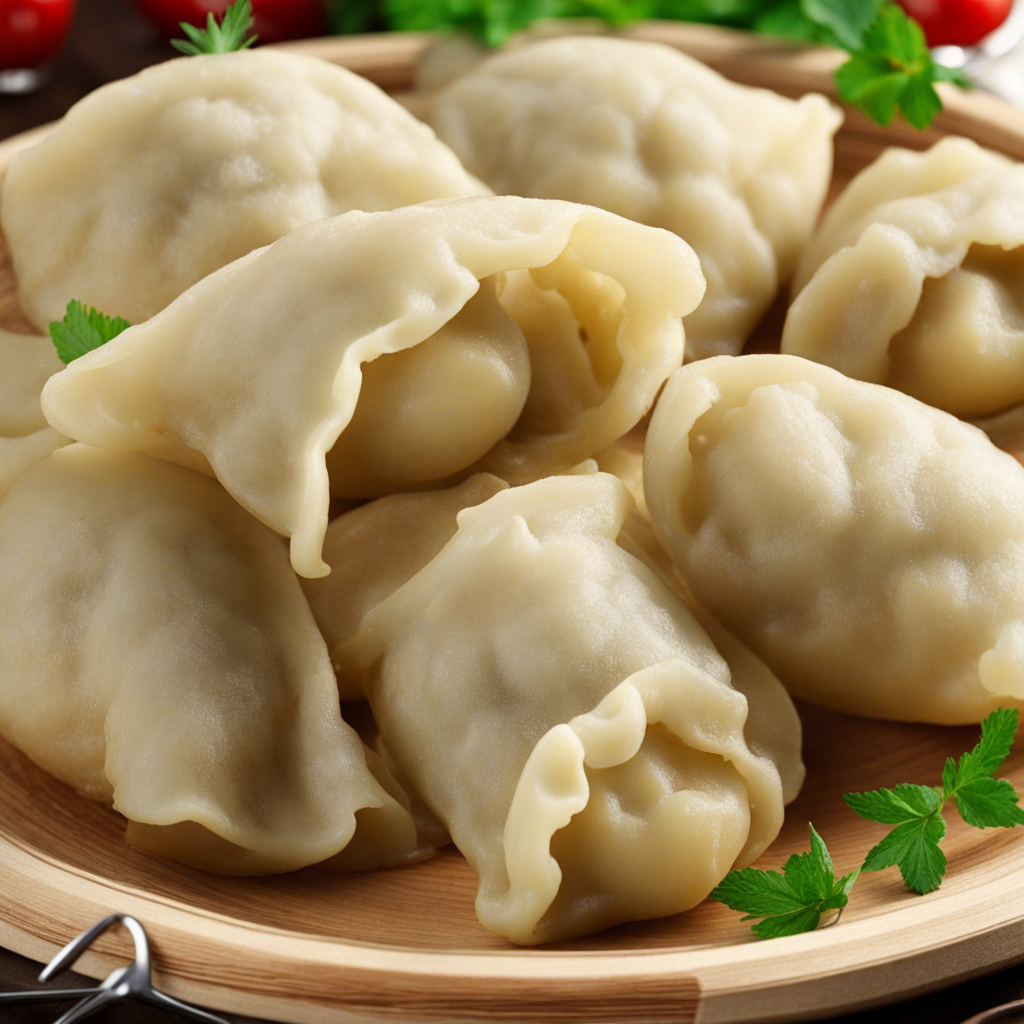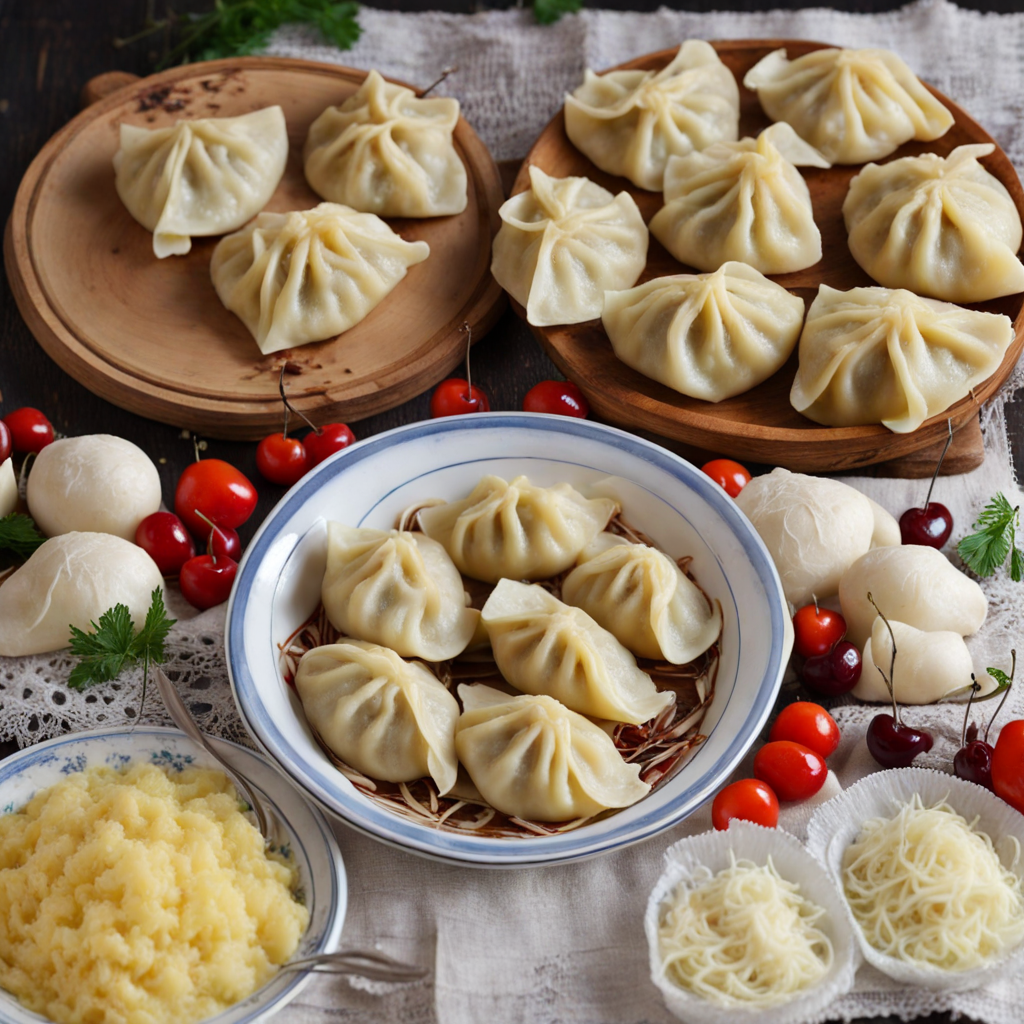Varenyky
Varenyky, often referred to as Ukrainian dumplings, are a delightful culinary treasure that encapsulates the heart of Ukrainian comfort food. These soft, pillowy pockets of dough are typically filled with a variety of ingredients, ranging from savory to sweet. The traditional fillings include mashed potatoes, cheese, sauerkraut, mushrooms, or ground meat, while sweet variations can feature cherries, blueberries, or sweetened cottage cheese. Each bite offers a harmonious blend of textures and flavors, with the tender dough enveloping the rich, flavorful fillings, creating a satisfying experience that is both hearty and comforting. These dumplings are usually boiled until they float to the surface, indicating they are perfectly cooked, and are often served with a dollop of sour cream or a drizzle of melted butter for added richness. The versatility of varenyky allows them to be enjoyed in various settings, whether as a main course, side dish, or even dessert. They are commonly accompanied by fried onions or crispy bacon, enhancing their flavor profile and providing a delightful contrast to the softness of the dumplings. Varenyky are not just a meal; they represent a cultural experience, often made during family gatherings and celebrations. The process of preparing varenyky can be a communal activity, where families come together to create these delectable treats, sharing stories and laughter. Each region in Ukraine may have its own unique spin on varenyky, with local ingredients and traditions influencing the fillings and preparation methods. This makes varenyky not only a dish to savor but also a delicious journey into Ukrainian heritage that invites you to explore the rich tapestry of flavors and traditions encapsulated in each dumpling.
How It Became This Dish
The History of Вареники: A Culinary Treasure of Ukraine #### Origins The origins of вареники (vareniki) can be traced back to the rich tapestry of Eastern European culinary traditions, particularly within the context of Ukrainian culture. While the precise beginnings of vareniki are difficult to pinpoint, they are believed to have emerged around the 14th century, paralleling the rise of wheat cultivation in the region. As a staple food, these dumplings reflect the agricultural practices and dietary needs of the Ukrainian peasantry, who relied on simple, accessible ingredients. The name "vareniki" comes from the verb "varit," which means "to boil" in Ukrainian. This reflects the traditional method of cooking these dumplings, which are typically made by enveloping various fillings in a soft dough. The simplicity of the ingredients—flour, water, and salt—was essential for the peasantry, who often relied on what they could grow or forage. #### Cultural Significance Vareniki are more than just a dish; they hold significant cultural importance in Ukraine. They are often associated with family gatherings, celebrations, and festive occasions. The preparation of vareniki is frequently a communal activity, where family members come together to mix the dough, prepare the fillings, and shape the dumplings. This communal aspect emphasizes the importance of family and tradition in Ukrainian culture. Different regions of Ukraine have their own variations of vareniki, showcasing the country’s diverse culinary landscape. Fillings can range from savory to sweet, including potatoes, cheese, cabbage, mushrooms, cherries, and even poppy seeds. Each filling carries its own significance, often linked to local agricultural practices or seasonal availability. Vareniki are also traditionally served during major holidays and religious observances. For instance, on Christmas Eve, it is customary to prepare a variety of dishes, including vareniki, as part of the Sviata Vecheria (Holy Supper). The dumplings symbolize prosperity and abundance, and sharing them among family is a way to express solidarity and love. #### Development Over Time As Ukraine evolved through various historical phases, so too did the preparation and significance of vareniki. During the 19th and early 20th centuries, Ukrainian nationalism began to rise, leading to a renewed interest in traditional foods. Vareniki were embraced as a symbol of Ukrainian identity and heritage, especially during times of foreign domination or cultural suppression. In the 20th century, particularly during the Soviet era, the availability of ingredients changed dramatically. The state-controlled economy often limited access to various foods, and traditional recipes were adapted to fit the available resources. Despite these challenges, the fundamental essence of vareniki remained intact, serving as a comforting reminder of home for many Ukrainians. With the dissolution of the Soviet Union in 1991 and the subsequent independence of Ukraine, there was a resurgence of interest in traditional foods, including vareniki. Chefs and home cooks alike began to experiment with modern interpretations while respecting traditional methods. This revival has led to a renaissance in Ukrainian cuisine, with vareniki taking center stage at both local eateries and fine dining establishments. #### Contemporary Variations and Global Influence Today, vareniki have transcended their humble origins and are celebrated not only in Ukraine but also in the broader Eastern European diaspora. In countries with significant Ukrainian populations, such as Canada, the United States, and Poland, vareniki festivals and cultural events showcase this beloved dish. These gatherings allow individuals to share their heritage and connect with their roots through food. Contemporary variations of vareniki have emerged, influenced by global culinary trends. Chefs experiment with fillings such as roasted vegetables, gourmet cheeses, and fusion flavors, appealing to a wider audience. The dough can also be made with alternative flours, accommodating dietary preferences such as gluten-free diets. This evolution reflects a broader trend in modern cuisine, where traditional dishes are reimagined to fit contemporary tastes and lifestyles. Vareniki have also found their way into popular culture, appearing in cookbooks, television shows, and social media. Food bloggers and influencers have embraced the dish, showcasing its versatility and inviting audiences to recreate it at home. This digital presence has helped to popularize Ukrainian cuisine globally, introducing new generations to the joys of making—and eating—vareniki. #### Conclusion The journey of вареники from humble peasant food to a symbol of Ukrainian identity and pride is a testament to the resilience and creativity of the Ukrainian people. This dish encapsulates the essence of community, tradition, and cultural heritage. As vareniki continue to evolve and adapt to new culinary landscapes, they remain a beloved staple, cherished not only for their taste but also for the memories and connections they evoke. In a world where globalization often leads to the homogenization of food cultures, vareniki stand out as a reminder of the importance of preserving culinary traditions. They embody the spirit of Ukraine—a nation rich in history, culture, and the simple pleasure of sharing a meal with loved ones. Whether enjoyed at a festive gathering, a family dinner, or a trendy restaurant, vareniki will undoubtedly continue to hold a cherished place in the hearts and stomachs of those who partake in their deliciousness.
You may like
Discover local flavors from Ukraine







